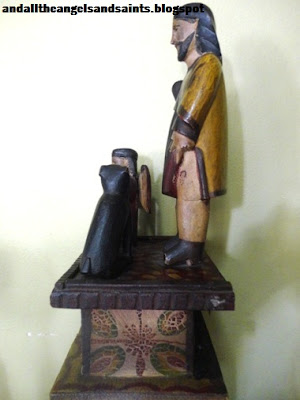Even when I could afford better quality santos, I still stuck to folk santos as my area of interest. I guess I was drawn to the folksy charm, the vibrant but haphazard colors and the raw craftsmanship, product of anonymous, unschooled native artisans. One of my early finds came as a result of an immersion project I was involved in, down South.
In 1984, my Client sent me to Iloilo and Bacolod to interview women about their laundry habits. Whenever there was a lull in my field work, I would make it a point to explore the place, and ask people around for any points of interest—restaurants, old churches, and yes—antique shops. It was in Molo that a kind local led me to the house of Iloilo’s foremost antique dealer and collector—Mrs. Lourdes Dellota. I have seen her formidable collection in a book about colonial santos, and I was determined to meet her and visit her shop, which was actually the first floor of her house.
Mrs. Dellota turned out to be a sweet, chatty lady, and she, at once, guided me to her shelves of santos for sale. I was immediately attracted to a small folk tableau of San Roque, no more than 14 inches tall, inclusive of the high, boxy base, and possibly made in the first decade of the 20th c.
I have seen similar San Roques carved and styled in the same manner, assembled in the same way—which led me to think that these, perhaps, were one of the earliest santos to be made in commercial quantities. But this example I singled out for its completeness (save for a missing hand and a staff) , bold, vivid color and excellent condition.
The principal figure itself of San Roque itself is notable for its coloration—the cape is painted a deep yellow, with floral trims, and the tunic is rendered in deep red. He lifts his tunic to reveal a wound on his knee—but somehow, the knee and the wound have been relocated on the side of the saint’s upper thigh!
The flat-topped angel with painted Oriental features is equipped with wooden wings. He holds a scroll with handwritten notations in Ilonggo, which couldn’t fully decipher. I could, however, clearly make out the word “peste”, referring to saint’s invocation against pestilence. The misshapen legs of the angel make it almost look like a midget!
The crudely carved black dog looks almost comical as it sits with its floppy ears and seated posture. He holds a semblance of a piece of bread in its mouth, also painted black.
The whole ensemble has been arranged on a ridged, hollow, rectangular base of thin wood. The red-painted top has been accented with dabs of yellow paint. A stylized red flower has been painted on the center of the base, from which 4 leaf designs radiate. The bottom of the base is painted in yellow, lined with red scallop patterns.
It is indeed amazing that inspite of the santo’s crudeness, the representation adhered strictly to the prescribed iconography of the pilgrim saint. I paid Php 650.00 for the tableau, which was a hundred bucks less than what one would pay for in Manila. To this day, thirty years after, San Roque and his companions remain to be a favorite in my collection, a fine example of the art of the Pinoy santero at its most exuberant.












No comments:
Post a Comment